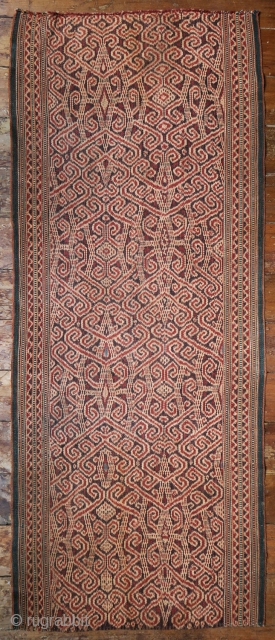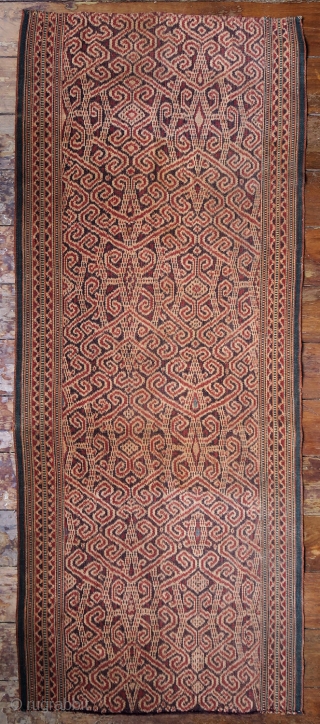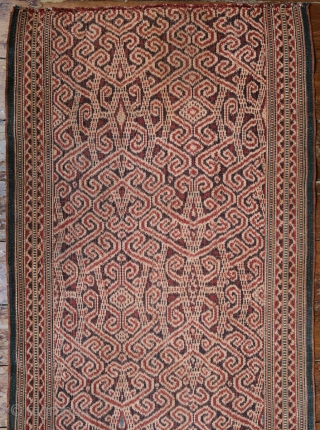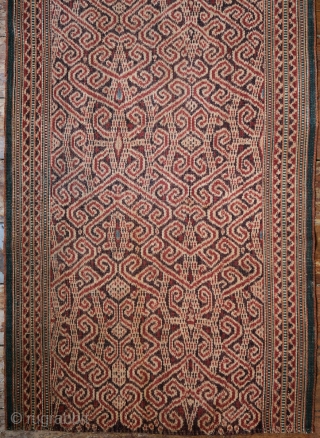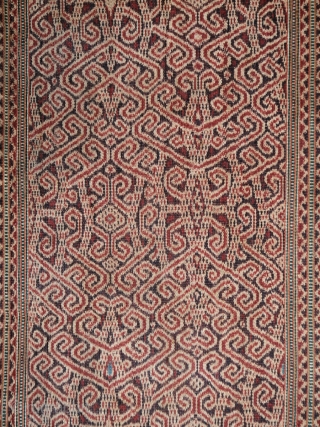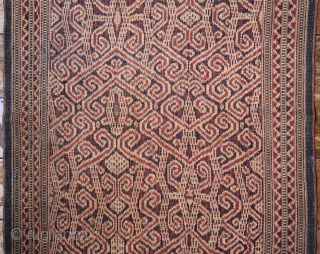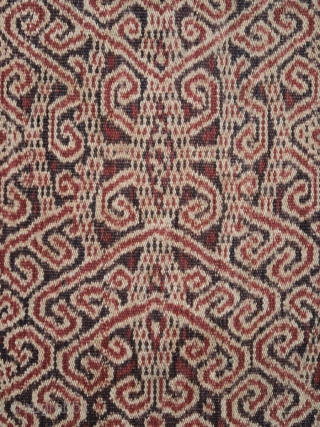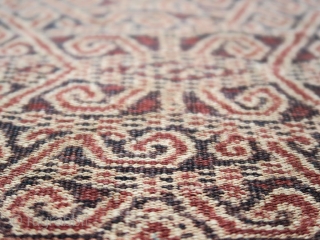Back
Kalimantan | early 20th c ikat Iban skirt (kain kebat or bidang) | Indonesia
Borneo, Kalimantan, 1920 - 1940
Handspun cotton, warp ikat, alternating warp-faced float weave, natural dyes
A lovely Iban woman’s skirt (kain kebat or bidang), woven in deep brown, brick-red and ecru ikat. a regular, harmonious symmetry is created by mirroring coils in a stacked, branching formation, alternating with a composite motif that has a diamond at the centre. The variation and asymmetry in this composite motif creates an organic effect. The changing size of the coils provides a pleasing effect of relief perspective, reinforced by the single colour range used to outline the coils and dot the vertical lines. Two borders with zigzag ikat at either side are interspaced by fine blue / white ribbed stripes of alternating warp-faced float weave. a rhythmical, strong piece of fine Iban ikat.
Context: Textile art has a sacred origin and ritual functions for the Ibanic people, as well as the more usual social ones. Textiles are integral in headhunting practices and shaman rites: the gifts given to the shaman who conducts the soul of the dead to the other world must include a skirt, and without these gifts she will not be able to return to the human world (m. Gittinger, Splendid Symbols, 1990, 218). Gittinger cites the myth of the headhunter who shot a bird, which turned into a skirt. The skirt belonged to the daughter of the god Singalang Burong, who then married the hunter, and the story recounts how she eventually returned to the gods, but her son was later taught the rituals for headhunting, textiles, and omen birds, which he brought back to mortals.
Iban ikat is highly prized for its powerful woven designs of great depth. Skirts contain some of the oldest known Iban patterns, that have been handed on without significant changes and are often related to plaitwork patterns on baskets and mats. Skirts do not have the same ritual efficacy as pua; a weaver would rest between making the pua that put her at risk by making skirts. While under-priced compared to the large pua because they are smaller textiles, the skirts are often much more intricate in design, take as long or longer to make, and contain some of the finest weaving of the Ibanic people.
Condition: The skirt is in very good condition and has been well looked after. There is slight uneven color resulting from wear, which is barely noticeable in person. There are no stains, holes or tears. The colours are clear, dark and rich, and the medium weight, handspun cotton is surprisingly fresh—still slightly stiff, crisp, with a firm body and grainy texture.
Length: 106 cm. Width: 44 cm.
Borneo, Kalimantan, 1920 - 1940
Handspun cotton, warp ikat, alternating warp-faced float weave, natural dyes
A lovely Iban woman’s skirt (kain kebat or bidang), woven in deep brown, brick-red and ecru ikat. a regular, harmonious symmetry is created by mirroring coils in a stacked, branching formation, alternating with a composite motif that has a diamond at the centre. The variation and asymmetry in this composite motif creates an organic effect. The changing size of the coils provides a pleasing effect of relief perspective, reinforced by the single colour range used to outline the coils and dot the vertical lines. Two borders with zigzag ikat at either side are interspaced by fine blue / white ribbed stripes of alternating warp-faced float weave. a rhythmical, strong piece of fine Iban ikat.
Context: Textile art has a sacred origin and ritual functions for the Ibanic people, as well as the more usual social ones. Textiles are integral in headhunting practices and shaman rites: the gifts given to the shaman who conducts the soul of the dead to the other world must include a skirt, and without these gifts she will not be able to return to the human world (m. Gittinger, Splendid Symbols, 1990, 218). Gittinger cites the myth of the headhunter who shot a bird, which turned into a skirt. The skirt belonged to the daughter of the god Singalang Burong, who then married the hunter, and the story recounts how she eventually returned to the gods, but her son was later taught the rituals for headhunting, textiles, and omen birds, which he brought back to mortals.
Iban ikat is highly prized for its powerful woven designs of great depth. Skirts contain some of the oldest known Iban patterns, that have been handed on without significant changes and are often related to plaitwork patterns on baskets and mats. Skirts do not have the same ritual efficacy as pua; a weaver would rest between making the pua that put her at risk by making skirts. While under-priced compared to the large pua because they are smaller textiles, the skirts are often much more intricate in design, take as long or longer to make, and contain some of the finest weaving of the Ibanic people.
Condition: The skirt is in very good condition and has been well looked after. There is slight uneven color resulting from wear, which is barely noticeable in person. There are no stains, holes or tears. The colours are clear, dark and rich, and the medium weight, handspun cotton is surprisingly fresh—still slightly stiff, crisp, with a firm body and grainy texture.
Length: 106 cm. Width: 44 cm.
price:
SOLD
- Home
- Antique Rugs by Region
- Category
- Profiles
- Post Items Free
- Albums
- Benaki Museum of Islamic Art
- Budapest: Ottoman Carpets
- Gulbenkian Museum
- Islamic Carpets. Brooklyn
- Islamic Textiles. Brooklyn
- Konya Museum: Rugs
- MKG, Hamburg
- MMA: Caucasian Carpets
- MMA: Mamluk Carpets
- MMA: Mughal Indian Carpets
- MMA: Ottoman Carpets
- MMA: Safavid Persian Carpets
- MMA: Turkmen Rugs
- McCoy Jones Kilims
- Ottoman textiles. Met
- Philadelphia Museum
- Rugs and Carpets: Berlin
- Seljuqs at the Met
- TIEM, Istanbul: Carpets
- V&A: Classical Carpets
- Vakiflar Carpets: Istanbul
- Baluch Rugs: Indianapolis
- Gallery Exhibitions
- Jaf an Exhibition
- Alberto Levi Gallery
- Andean Textile
- Christie's London: 2016
- Francesca Galloway
- HALI at 40
- ICOC Washington, DC 2018
- Jajims of the Shahsavan
- London Islamic Week April, 2018
- Mongolian Felts
- Navajo Rugs: JB Moore
- Persian Piled Weavings
- SF Tribal & Textile Art Show 2020
- SF Tribal 2019
- Sotheby's: C. Alexander
- Turkish Prayer Rugs
- Turkmen Main Carpets ICOC 2007










